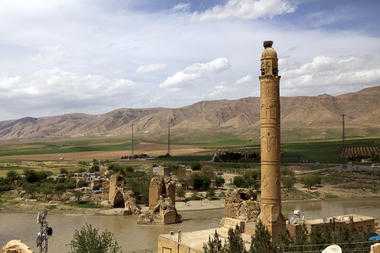The ancient Turkish city of Hasankeyf fights for survival as a new damn is planned.
By Constanze Letsch, / Contributor / June 17, 2011

Hasankeyf, a city overlooking the Tigris River in the Southwestern Anatolia region in Turkey, prides itself on being the oldest inhabited settlement on earth. Having withstood the trials of millenniums and the occupation of civilizations from the Romans, Byzantines, Assyrians, Arabs, and Mongols to the Ottomans, all of whom left their mark, the ancient town now faces the threat of being flooded.
The construction of the Ilisu Dam, officially designed to improve the economy in Turkey’s predominantly Kurdish southeast, would see the end to more than 6,000 years of permanent settlement and the relocation of 50,000 residents.
Firat Argun, who runs a guesthouse by the banks of the river, rallies against the construction of the dam. “Our roots are here, much like those of a tree,” he says and gestures around him. “This is the only place where I am at peace.”
His ancestors migrated to Hasankeyf from Baghdad 300 years ago, and like many local residents, he cherishes his Arab identity. His father and mother both grew up in one of the thousands of caves that dot the cliffs surrounding Hasankeyf where people used to live until the 1970s, when Süleyman Demirel, then prime minister of Turkey, ordered the construction of public housing and the relocation of the cave dwellers.
“The government declared Hasankeyf a protected historic area in 1978,” Mr. Argun says. “We were not allowed to move even a single stone. How can they now come and flood the whole town?”
The remains of an early medieval bridge that once provided the only passage over the river to Silk Road travelers still withstands the currents of the Tigris today. The Zeynel Bey Mausoleum on the north banks of the river dates back to 1473, when the Turkic tribe of the Ak Kuyunlu made Hasankeyf its capital. With its Kufic patterns of glazed turquoise tiles covering the walls, the tomb is one of the few examples of Central Asian architecture in the Anatolia region.
More than 300 historical sites lie scattered in and around Hasankeyf, many of which remain unexplored and will be lost once the dam is finished.
Last July, in an overly hasty excavation of some archaeological sites using heavy machinery, a cliff collapsed and killed a man, according to Berne Declaration, a Swiss nongovernmental organization. After the accident, the authorities closed down the main historical site, which includes a Byzantine castle perched atop a cliff overlooking the Tigris. It was reopened last month.
Despite the dam’s ongoing construction, the Ministry of Culture tendered for maintenance work on several historical sites last year, including the mausoleum and a medieval hamam, or public bath. Ali, a bricklayer from the nearby town of Batman, says: “I know that all of this will be flooded,” pointing toward a low wall that has just been covered with cement. “So I am not sure why I am doing this.”
via Turkey’s riverside refugees – CSMonitor.com.

Leave a Reply